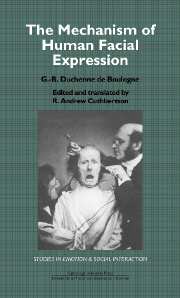Book contents
- Frontmatter
- Contents
- Acknowledgments
- Contributors
- Editor's Preface
- Part 1 The mechanism of human facial expression or an electrophysiological analysis of the expression of the emotions
- Preface
- A Introduction
- Chapter 1 A review of previous work on muscle action in facial expression
- Chapter 2 Principal facts that emerge from my electrophysiological experiments
- Chapter 3 The reliability of these experiments
- Chapter 4 The purpose of my research
- B Scientific section
- C Aesthetic section
- Part 2 Commentary chapters
- Index
Chapter 4 - The purpose of my research
Published online by Cambridge University Press: 10 November 2010
- Frontmatter
- Contents
- Acknowledgments
- Contributors
- Editor's Preface
- Part 1 The mechanism of human facial expression or an electrophysiological analysis of the expression of the emotions
- Preface
- A Introduction
- Chapter 1 A review of previous work on muscle action in facial expression
- Chapter 2 Principal facts that emerge from my electrophysiological experiments
- Chapter 3 The reliability of these experiments
- Chapter 4 The purpose of my research
- B Scientific section
- C Aesthetic section
- Part 2 Commentary chapters
- Index
Summary
Assuredly, nobody will contest the originality of my electrophysiological experiments on facial expression. I will try to summarize their use from the anatomical, physiological, and psychological points of view, and to indicate their happy or fortunate applications to the study of the Fine Arts.
The application to anatomy and physiology
A. Most of the facial muscles seem to continue one into the other, especially when you study them from the inside. M. le professeur Cruveilhier has been good enough to show me some figures depicting anatomical preparations that he had made with the object of studying the “inner view” of the muscles, after having detached the soft tissue of the face, en masse, from the bones. In these preparations all the muscular fibers seem to merge, one with the other, so that one is not able to assign exact limits to most of the facial muscles.
If this fibrillar continuity of the facial muscles were real, their independence would be highly compromised, if not annulled. Does a muscle contract in a portion of its length or in its entirety? And what then should one take as the fixed point? In brief, this continuous fibril doctrine, which converts all the muscles of the face into a mask of facial expression, cannot explain the mechanism of this crowd of tiny independent movements that write the numerous feelings of the soul on the face in characters that are always identical.
- Type
- Chapter
- Information
- The Mechanism of Human Facial Expression , pp. 22 - 38Publisher: Cambridge University PressPrint publication year: 1990

